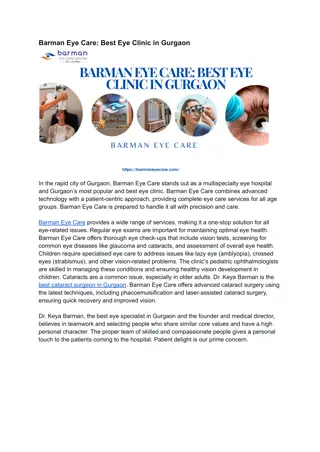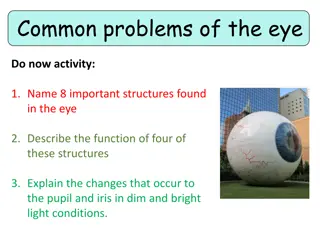
Conjunctiva of the Eye_ Everything You Need to Know
In this blog, we will delve into the structure, functions, common conditions, and care tips for the conjunctiva of the eye.
Uploaded on | 0 Views
Download Presentation

Please find below an Image/Link to download the presentation.
The content on the website is provided AS IS for your information and personal use only. It may not be sold, licensed, or shared on other websites without obtaining consent from the author. If you encounter any issues during the download, it is possible that the publisher has removed the file from their server.
You are allowed to download the files provided on this website for personal or commercial use, subject to the condition that they are used lawfully. All files are the property of their respective owners.
The content on the website is provided AS IS for your information and personal use only. It may not be sold, licensed, or shared on other websites without obtaining consent from the author.
E N D
Presentation Transcript
Conjunctiva of the Eye: Everything You Need to Know About This Vital Eye Membrane The conjunctiva is a vital part of the eye that plays a crucial role in maintaining eye health and function. Despite its small size, the conjunctiva has significant responsibilities, including protecting the eye from infections and providing a lubricated surface for the eye. In this blog, we will delve into the structure, functions, common conditions, and care tips for the conjunctiva of the eye. What is the Conjunctiva of the Eye? The conjunctiva is a thin, transparent membrane that covers the white part of the eye, known as the sclera, and lines the inside of the eyelids. It is composed of two parts: 1. 2. Palpebral Conjunctiva: This part lines the inner surface of the eyelids. Bulbar Conjunctiva: This part covers the sclera.
Functions of the Conjunctiva of the Eye The conjunctiva serves several essential functions: 1. Protection: It acts as a barrier against dust, microorganisms, and other foreign particles. 2. Lubrication: The conjunctiva produces mucus and tears that keep the eye moist and reduce friction during blinking. 3. Immune Defense: It contains immune cells that help protect the eye from infections. Common Conditions A?ecting the Conjunctiva of the Eye The conjunctiva can be a?ected by various conditions, some of which are more common than others. Here are a few notable ones: Conjunctivitis (Pink Eye)
Conjunctivitis, commonly known as pink eye, is an inflammation of the conjunctiva. It can be caused by infections (bacterial or viral), allergies, or irritants like smoke or dust. Symptoms include redness, itching, swelling, and discharge from the eye. Types of Conjunctivitis: 1. Viral Conjunctivitis: Caused by viruses, highly contagious, and often associated with respiratory infections. 2. Bacterial Conjunctivitis: Caused by bacteria, characterized by yellow or green discharge. 3. Allergic Conjunctivitis: Triggered by allergens like pollen, pet dander, or dust mites. Pterygium A pterygium is a benign growth of the conjunctiva that extends onto the cornea. It is often linked to prolonged exposure to ultraviolet (UV) light, wind, or dust. Symptoms include redness, irritation, and a visible growth on the eye. Pinguecula
A pinguecula is a yellowish, raised spot on the conjunctiva, usually found near the cornea. It is typically caused by UV light exposure and can lead to dryness and irritation. Diagnosing Conjunctival Conditions Diagnosis of conjunctival conditions involves a comprehensive eye examination by an eye care professional. The process may include: 1. Visual Inspection: The doctor examines the eye for redness, swelling, discharge, and any visible growths. 2. Slit-Lamp Examination: This specialized microscope allows the doctor to examine the conjunctiva and other eye structures in detail. 3. Swab Test: In cases of suspected infection, a swab of the discharge may be taken to identify the causative organism. Treatment Options for Conjunctiva of the Eye The treatment for conjunctival conditions varies based on the underlying cause: For Conjunctivitis 1. Viral Conjunctivitis: Often self-limiting and may resolve without treatment. Cold compresses and artificial tears can provide relief. 2. Bacterial Conjunctivitis: Treated with antibiotic eye drops or ointments. 3. Allergic Conjunctivitis: Managed with antihistamine or anti-inflammatory eye drops and avoiding allergens. For Pterygium and Pinguecula 1. Pterygium: Mild cases may require lubricating eye drops. Severe or vision-impairing cases might need surgical removal. 2. Pinguecula: Usually managed with lubricating eye drops. If it causes significant discomfort, steroid eye drops may be prescribed. Preventive Measures for Conjunctiva of the Eye Maintaining the health of the conjunctiva involves simple but e?ective measures:
1. Eye Protection: Wear sunglasses to protect against UV light and safety glasses in environments with dust or chemicals. 2. Good Hygiene: Wash hands frequently and avoid touching the eyes to reduce the risk of infections. 3. Avoid Allergens: Minimize exposure to known allergens by keeping living spaces clean and using air filters. 4. Proper Contact Lens Care: Follow hygiene practices and wear schedules to prevent infections related to contact lenses. Importance of Regular Eye Check-Ups Regular eye examinations are crucial for early detection and management of conjunctiva of the Eye. Eye care professionals can provide personalized advice on maintaining eye health and preventing complications. Conclusion The conjunctiva of the eye is an essential structure that ensures the protection and lubrication of the eye. Understanding its functions and the common conditions that a?ect it can help in maintaining good eye health. By following preventive measures and seeking
timely treatment for any issues, you can keep your eyes healthy and functioning well. Regular visits to an eye care professional will further ensure that any problems are detected and treated early, preserving your vision and overall eye health. Find practical solutions to common challenges through our insightful articles on Healthcare 360 Magazine






















